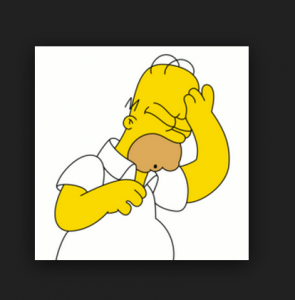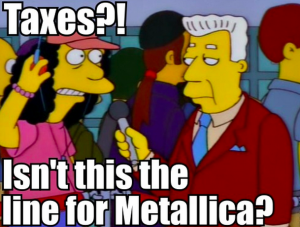
D’oh!
The government’s latest gaffe could signal new problems with the complex links between ACA/Obamacare and the nation’s income tax system.
A basic summation of the faux pas:
Officials said the government sent the wrong tax information to about 800,000 HealthCare.gov customers, and they’re asking those affected to delay filing their 2014 returns. The issue involves a new government form called a 1095-A.
You are probably asking yourself:
What does health insurance have to do with taxes?
What is a 1095-A form?
Do I need a 1095-A form?
How do I know if I have an inaccurate 1095-A form?
What if I misplaced my 1095-A form?
What should I do if I don’t need a 1095-A form?

Health Insurance and your Taxes.
This year the health care law will bring some changes to the 2014 federal income tax return that individuals file in 2015. This year marks the first time that taxpayers will be asked questions related to health care coverage, i.e. Did you have qualified coverage for 2014.
Do I need a 1095-A, Health Insurance Marketplace Statement? What is a 1095-A form?
If you or your family had qualified coverage through Healthcare.gov/marketplace, i.e. you received a subsidy through healthcare.gov/marketplace, then the Marketplace/healthcare.gov will send you information about your coverage on a Form 1095-A.
You should have received this form mid-February. The form will show details of your insurance coverage such as:
- the effective date,
- amount of the premium (what you pay each month); and
- your subsidy (reduction in your monthly premium due to your income).
Individuals will use the information on Form 1095-A to complete Form 8962, Premium Tax Credit (PTC) in order to claim the premium tax credit or to reconcile advance credit payments on the federal tax return.
Individuals may receive more than one Form 1095-A if anyone in their households switched plans in 2014 or reported life changes (such as getting married or having a baby) after their coverage began, or if they had more than one policy covering people in the same household. Individuals will get a Form 1095-A even if they only had Marketplace coverage for part of 2014.
How do I know if I have an inaccurate 1095-A form?
Taxpayers who receive a Form 1095-A in the mail from the Marketplace should check to make sure the information matches their records, including items like the start and end dates of their coverage and the number of people in their household. Anyone who believes the information on the Form 1095-A is incorrect, should visit healthcare.gov/taxes or call healthcare.gov call center 1-800-318-2596, to find out how to get a corrected Form 1095-A.
What if I misplaced my 1095-A form?
Find your Form 1095-A
- Log in to Marketplace account-be sure to put in your username and password.
- Select your 2014 application-be sure you’re not choosing your 2015 coverage application.
- Select “Tax forms” from the menu on the left.
- View or download each Form 1095-A.
- All 1095-As are also available with your Marketplace messages.
- If you can’t find your 1095-A online, contact the Marketplace Call Center at 1-800-318-2596.
What should I do if I DON’T need a 1095-A form?
This year, unless a taxpayer purchased coverage from the Marketplace, many people will not receive tax information documents related to their health coverage.
Rather than filing the 1095-A form, most taxpayers simply need to check a box indicating they had qualifying health care coverage for the entire year. You will not be required to file documents proving qualifying insurance coverage. Next year, however, people who have qualifying health care coverage will receive tax information documents that are comparable to Forms W-2 and 1099.
If you don’t have qualifying health coverage due to your low income (you are below the subsidy threshold) you must file a new form/documentation to claim an exemption from the requirement to have health care coverage. This includes documentation to support a hardship, income documents, social security information, and household information. If an exemption application is granted by the Marketplace the applicant will receive a notice with a unique Exemption Certificate Number, also known as an ECN. The ECN will be entered in Part I of Form 8965, which must be filed with the tax return. Individuals who do not currently have their ECN, but who have applied for an exemption through the Marketplace, should enter the word “PENDING” in the place of the ECN in Part I of Form 8965. If you are claiming an exemption on your tax return, you do not need an ECN. There are many exemptions out there so be sure to talk to your tax guy or gal!
If you do not have qualifying health care coverage, through an employer or private insurer, and do not qualify for an exemption you will be required to pay a penalty for going uninsured. A penalty will be assessed when you file your tax return. If you were unaware of the penalty and plan on filing for 2014, then you qualify for a Special Enrollment period and may enroll in an insurance plan to avoid the higher penalty that will be assessed in 2015. You may enroll under this Special Enrollment Period from March 15 – April 30, 2015.
In Conclusion:
If you purchased coverage through the Health Insurance Marketplace, you should have received your Form 1095-A, Health Insurance Marketplace Statement in mid-February. Submit this form with you 2014 tax filing.
If you did not go through the marketplace and instead received insurance through your employer or through a private insurer you will not be required to show proof of coverage for the 2014 tax year. Simply check the appropriate box when filing.
If you qualify for a health coverage exemption, you WILL need to file the appropriate documentation on your tax return.
Call if you need assistance signing up under the 2015 Special Enrollment Period. Also, if you are looking for a qualified CPA, I can point you in the right direction.
Best of luck!

